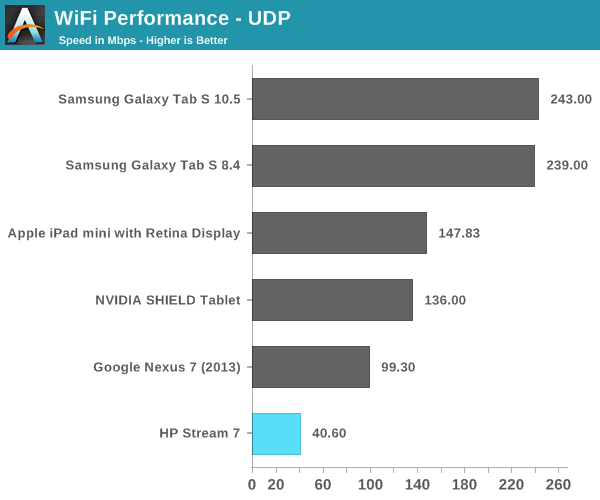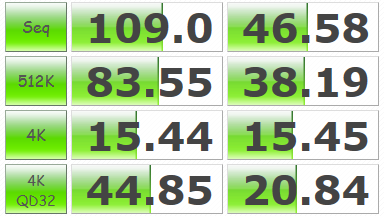HP Stream 7 Review: A $119 Windows Tablet
by Brandon Chester on December 19, 2014 8:00 AM ESTCamera
It looks like including a camera is now a requirement for pretty much any device, and so even the Stream 7 has a front-facing and a rear-facing camera. In the Windows device manager, the front camera identifies itself as "Camera Sensor GC310". I haven't been able to find any information about it, but the image quality leads me to believe that it may be best for people to not know where it came from. The rear camera idenitifes itself as HM2056, which I was able to find information about. It's made by a company called Himax Imaging, and if you haven't heard of them it's okay, because I hadn't either. It's a 2MP 1/5" sensor, which translates to 1.75 micron pixels. It has no auto focus, and that combined with the specifications leads me to believe that this is normally intended to be a front-facing sensor.
As you can see, the output is really bad. The text on the back of the books is illegible, most detail is lost, and there's noise everywhere. It's just honestly not a good camera, and it's something I would only use as a last resort. It's somewhat annoying that HP felt the need to even put a rear camera on the Stream 7, as it adds to the BOM and the money could have been better used on something like a larger battery.
NAND
I mentioned earlier that the Stream 7 doesn't even have enough storage to fit PCMark 8 and some of the other benchmarks we use. Out of the box, you get around 18.5GB free. This means that we can't run our typical Windows storage benchmarks, so I've used CrystalDiskMark to get an idea of how the storage performs.
I wouldn't try making direct comparisons between this and our storage benchmarks on Android and iOS, but it's still able to give you an idea of what you can expect. The Stream 7 uses Samsung's MGB4GC eMMC solution, so we can't expect the same storage performance that you get from Windows devices with a full blown SSD. The read and write performance ends up being pretty good for an eMMC solution, although I'm suspicious of the 4k random write result considering how even the best eMMC solutions we've seen in Android and iOS tablets top out around 3MB/s.
WiFi
The HP Stream 7 uses a Realtek RTL8723BS solution for WiFi and Bluetooth. This is a single spatial stream 802.11n part, with no 5GHz support and only 20MHz channel width. That means that we're dealing with a theoretical maximum speed of 72Mbps. In real world use, it's quite a bit less, as you can see below.

Again, at $119 this is expected and can be excused. Faster WiFi would be nicer, but it's not free. My only complaint about this speed in the real world is that the slow WiFi makes it difficult to move large files over the network onto the Stream 7. This wouldn't be an issue if these Windows tablets allowed you to directly move files to them from another computer over USB, but they don't. I've also encountered issues with the WiFi disconnecting intermittently, which is incredibly frustrating when it means you have to begin transferring a large video from the beginning. I've contacted HP about this to see if they're aware of this issue, as I've seen complaints about it from other users, but I haven't received a response.
Misc
I am unfortunately not equipped to do objective audio testing on the Stream 7. It uses Realtek's audio codec, and so it isn't likely to be anything exceptional. The bottom mono speaker is adequate; there's not much to be said about it. Unfortunately, everything comes crashing down when you try to use the 3.5mm jack. Even if the Stream 7 had the best audio solution in the world, it would be crippled by this defect that I cannot believe made it to production.
Essentially, the 3.5mm jack has a great deal of noise and static, and it makes it effectively unusable. I have confirmed this with two other owners, and there are complaints about it on the web. It's likely that there's an insufficient amount of shielding for the audio port and PCB connections, and it's extremely disappointing. With its support for all the great video players on Windows, the Stream 7 could have been an inexpensive and powerful video player. But unless you're going to use the built-in speaker or Bluetooth headphones/speakers, there's no way to listen to audio on this tablet. When I reached out to HP about the WiFi connection issues I also asked about this, but again I haven't received a response.


















157 Comments
View All Comments
SanX - Friday, December 19, 2014 - link
Any tablet or phone with less then 1920x1080 must go straight to the drain or dollar storeBMNify - Friday, December 19, 2014 - link
Thanks for the review, inexpensive but decent windows 8.1 tablets are generally ignored by PR driven tech media. Will like to see the reviews of other Baytrail tablets like Dell Venue 8 pro, Acer iconia W4, Asus Vivotab Note 8 and Lenovo Mixx 2 8.sonicmerlin - Friday, December 19, 2014 - link
The biggest problem with Windows is that the Metro UI is boring and even ugly. It's claustrophobic and gets old real quickly.PC Perv - Friday, December 19, 2014 - link
Pathetic tablet and pathetic review to "excuse" its shortcomings. Amazon Kindles are way better deals.garbagedisposal - Friday, December 19, 2014 - link
Said no one ever. Time to climb back into the dumpster you little troll.PC Perv - Saturday, December 20, 2014 - link
Rofl. HP Stream 7 is just the right tablet for your, for just $119. Enjoy.I'd rather donate that money to UNICEF.
digiguy - Friday, December 19, 2014 - link
For those looking for a 8 inch Windows tablet with 4GB of RAM, it exists. And it also has 128 GB of (emmc) storage, the most powerful atom CPU (z3795, not very far from some i3 but fanless), micro HDMI, USB 3.0, full HD and LTE. It is the updated version of Thinkpad 8. Here in Europe it costs a little less than the Surface pro 3 with i3.... I would have bought one if weren't for lack of a stylus (essential for me in such a small, but premium, tablet...)Spectrophobic - Friday, December 19, 2014 - link
I got my Stream 7 for $64.10 from the MS Store; bought it due to being morbidly curious about how Windows run with only 1GB memory. Turns out, not bad. Well, while it's still predominately memory-bottlenecked, things can go smoothly when used the right way. In terms of web browsing, you pretty much have to stick to desktop/Metro IE. Chrome is fine when you only work with a single tab. YouTube videos are only good up to 720p on most videos and the same applies to x264 videos.The only real gripe with the thing is audio; the speaker sucks and the 3.5mm jack has static. I refuse to hear any audio coming out of this thing, unless if you put a USB DAC/amp with it. My unit unfortunately contains dead pixels. Minor, but my OCD refuse to forget about it. Kinda considering returning it...
In the end of the day, it's a good tablet for the money that is actually back by a known company. It's good, not very good, just barely good. But, I still consider it as a "toy" due to its limitations. Hopefully, a company would come up with a Windows 10 (with Bing?) with a decent SoC with 3GB RAM, 10" 1920x1200, and a stylus (that can fit into the thing) for $300.
sonicmerlin - Friday, December 19, 2014 - link
Except the Zoom in function to increase font size doesn't even work in IE (or Chrome). It just zooms in the entire page, making it impossible to zoom out. It's extremely annoying having to read small font on a low res screen.Spectrophobic - Friday, December 19, 2014 - link
Uhhh, I don't have any problems with zooming in or out in Chrome, Desktop IE, or Metro IE. By "Zoom in function to increase font size" do you mean: 1) Pinch zooming, 2) Web browser scaling, or 3) Windows scaling?Also I'm on 125% windows scaling.